interviews
Archived Posts from this Category
Archived Posts from this Category
Posted by jason + leslie on 23 Nov 2009 | Tagged as: interviews
For the third and final installment of our interview series with San Antonio art luminaries (see previous interviews, Easy Rider and Prodigal Son), we spoke with Anjali Gupta, executive director and editor-in-chief of Art Lies contemporary art quarterly. If it hasn’t been angelic qualities that have fueled this woman’s meteoric rise through the Nebula of Texan Art, than it has been her dogged work ethic, keen sense of telemetry, her concentrated gravity, and her superhuman ability to detect faint wisps of bullshit. She cannot hide her roots–tracking them all over the house on her boots–Gupta is a seasoned DIY commando, a builder of community and an emissary for that community cosmos-wide. We sat with her at our home and hers, both on San Antonio’s southside.
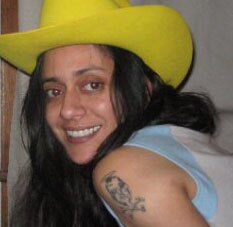
You were one of the driving forces behind the legendary Wong Spot in San Antonio. Tell us a little bit about the Wong days.
The Wong Spot began in a lovely building on South Flores, the old Wong’s Grocery Store, just a few months after I relocated here from Austin. Initially, it was a co-op consisting of artists James Cobb, Alex Rubio, Regis Shephard, Gary Sweeney and my ex-partner, Robert Tatum. At the time, I still had a somewhat regular studio practice, but my role was primarily what it always ends up being: the enabler. I dealt with logistics. Don’t get me wrong—it was a blast—and through Robert’s existing contacts in the San Antonio art community, it was wildly popular. We were also fortunate enough to be spitting distance from Jesse Amado and Chuck Ramirez’ studios, as well as Franco Mondini-Ruiz’ botanica. Such proximity fostered a certain synergy still prominent and strategically successful in the San Antonio visual arts community, Unit B and Sala Diaz being perfect examples.
We did everything on a shoestring. It was truly a community effort. When we relocated to East Commerce, however, it became an all-out business venture: a full kitchen, bar and a staff of 14 in a 10,000 square foot space. We staged weekly mini shows, monthly gallery shows, weekly film screenings and music five nights a week. (Did I mention that I was also running a video postproduction house out of the same building during the day?) It was a veritable circus, and ultimately—sans trust fund—sadly and inevitably unsustainable. But we didn’t really learn our lesson. Robert and I moved on to a series of smaller endeavors including Ellis Bean (which I quickly backed out of due to the, um, idiocy factor), The Honey Factory and 811 on Guadalupe and, finally, booking and curating the Wiggle Room for a spell. During this period, I survived on freelance writing gigs, graphic design jobs, gardening on the Riverwalk and producing videos, primarily for artists-in-residence at Artpace. I then woke up one day and consciously opted for a career instead of a series of really expensive and exhausting hobbies. Ten years, two paragraphs. Whew.
As somebody who grew up in Texas but has branched out, how has your opinion of the Texas art scene changed?
Actually, I spent half my formative years on the East Coast. I’m also a first generation American, which certainly shaped my psyche much more than being a “Texan.” My interest in the arts began as child (I was a fairly talented painter and my parents encouraged this), was fostered by my sister in my teens (she is an art historian and curator), by studying abroad in Germany and by my previous incarnation as an ethnographic filmmaker, which landed me in San Francisco in the early 90s working for Survival Research Labs.
That said, I have lived in Spring (just outside of Houston), Dallas, Austin and now San Antonio. Clearly, there is a distinct timbre in each of these cities and, by extension, a “Texas art scene.”
From your idiosyncratic perspective, is it all piñatas and cowpokes, or is there hope for other Texas art outside of Texas?
Mmmmk. At least you didn’t say scatological.
I assume by “hope” you mean an audience, and furthermore, success. My question to you is what yardstick do you, as an artist, use to measure success? Mine stick is qualitative, not quantitative. It is made in Texas out of imported wood and yes, it can beat the crap out of your piñata.
Have you seen any New Media artwork lately that has had an impact on you?
Sure. Some enchanting and some disappointing, which is to be expected no matter what the media.
Prove that you’re telling the truth, and name one. And tell us where you saw it and what made it stand out from all the other sermons you’ve heard in the last year.
Miguel Angel Rios’ 2008 video series White Suit, Crudo and Matambre comes to mind. I first saw them in person at the 2009 Armory Show, which was the perfect venue for this work—a hands down smack down—a balls out parody of the art industry. What makes this work stand out is that is not a sermon at all. I like art on the secular side of the spectrum. I don’t like to be preached at.
What is the difference between contemporary art and art made contemporaneously?
Content.
If you’re lining your eyeballs up with the fine line that separates the two, what can you see on either side?
Shit/Shinola. Please see David Robbins’ Brie Popcorn in Art Lies 52.
Do you ever get too much art?
If I do, it is probably time for a career change.
How do you cope?
I don’t. I allow myself the latitude to act out with impunity.
So, despite rumors, there are no outstanding warrants for your arrest?
I didn’t say that.
How can artists be productive members of society outside of the art world?
That is reductive. The art world is an imaginary space.
There are a lot of people going into debt pursuing degrees to prepare themselves for that imaginary space.
The industry of the MFA is problematic any way you look at it. I know plenty of smart, talented artists (and curators and art historians) with advanced degrees working multiple unpaid internships and/or bartending, driving cabs, stripping, walking dogs for cash, etc. This is nothing new. Spillage is normal and healthy. The very idea that a degree is somehow an automatic direct flight ticket to see the wizard is a very strange fallacy—one quite obviously reinforced in the labyrinths of our upper learning institutions. People coming out of prestigious MFA programs are simply not prepared for rejection, and let’s face it, even rejection has to be earned. Perhaps the idea of a PHD in studio art is a temporary solution to your question. That way, by the time these kids get out of school, they will be totally incapable of dealing with the real world and well prepared for the comforting and insular interior of a padded cell.
How did the economic crisis impact artists and the art industry?
How did it or how is it? We’re all still pretty fucked, top to bottom, coast to coast. Anyone who says differently is trying to sell you a self-help seminar. Funding freezes. Hiring freezes. Layoffs. Cutbacks. Ad budgets slashes. Programming halts. Tenure track position cuts. Gallery closures—I could go on, but the bottom line is now is the time to get creative. Collaborate. Pool resources.
Survive.
Posted by thomas-cummins on 19 Sep 2009 | Tagged as: interviews, sneak peeks, tv
Art21 returns this October with its 5th season which will premiere on KLRN on Wednesday, October 7 at 10:00 p.m. Being publicly funded, PBS has had some problems, in the past, creating shows about art and often supported kitsch values – as seen most evidently in the show ‘The Joy of Painting’ which was hosted by cultural icon Bob Ross. Similarly, NPR often supports Classical music as opposed to avant-garde or cutting edge music/sound art. While Classical music needs to still be appreciated and have a venue – it represents another generation and era. Art21 got it right by documenting some of the most prominent artists in the field today and this season’s first episode will showcase William Kentridge, Doris Salcedo, and Carrie Mae Weems.
Posted by jason + leslie on 29 Jun 2009 | Tagged as: interviews
Potter-Belmar Labs interviews Franco Mondini-Ruiz
May 22, 2009, San Antonio TX

Years ago, Franco Mondini-Ruiz quit a high-paying job in law, paid off his bills, took an extended self-desribed rite-of-passage-trip into Mexico, and then opened his infamous salon and art installation, the Botanica Infinito, on Flores Street in his hometown of San Antonio. With this was launched an art career that took him all over the world, moving to New York City, contributing to the 2000 Whitney Biennial, winning the Rome Prize, lunching with the Queen of Egypt, and certainly much more.
A decade later, in 2006, San Antonio’s glamorously irreverent bad boy returned home to roost, establishing a lush and bountiful hacienda pregnant with beauty, poetry and art. Faint echos of the Warhol Factory hang in the air with a swirl of beautiful assistants, dangerous pleasures, and wild, opulent parties, all in the service of and made possible through Mondini-Ruiz’ art making practice.
The son of an upper-middle class Italian Air Force man and a Spanish/Mexican beauty, Mondini-Ruiz is known by many as a generous, yet social boundary-pushing, provocateur. He has both struggled through and reveled in the myriad contradictions of class, culture, and ethnicity that infuse and enrich his life. A model hybrid who lives the reality of being “not quite one nor the other,” he owns the differences, fuses them together and enshrines them within his art.
Potter-Belmar Labs interviewed Franco Mondini-Ruiz at his west side domicile, in the bedroom he claims to have been his great grandmother’s.
[This interview is part of a three-part series. Read Potter-Belmar Labs interview with ArtPace Director, Matthew Drutt, also on Emvergeoning.]

Emvergeoning: Tell us a little about the Botanica Infinito.
Franco Mondini-Ruiz: The Botanica was a readymade when I bought it. It was a pre-existing botanica and it had inventory all the way from the 60’s. Beautiful place. It was called Infinito Botanica, and underneath, it said “Amor, Dinero, y Paz y Tiempo de Gozarlo,” in my very best Spanish, which I think means “Love, Money, and Peace, and Time to Enjoy It.” Unfortunately, some architects bought the building — friends of mine whose names will go unmentioned — and they painted out that gorgeous little mural, which was featured in the Whitney Biennial catalog.
Emvergeoning: How does being from Texas affect your work?
More specifically than being from Texas, I have made a living being an artist from San Antonio. Texas scares people ’cause there’s, you know, they think of Bush, they think of wealth. They’re fascinated by it. They’re interested in it. But San Antonio is very intriguing to a lot of people all over the world. There’s enough mystery to it that people are intrigued. I really have made a career of it, and I don’t mean that facetiously or to be cavalier. A lot of us from San Antonio, who either were born here or moved here, we love it. It’s the love of my life, and it even breaks my heart, sometimes.
I have to watch out and not over-romanticize it, and not to just say, “oh, because San Antonio is part of me, I want to build it up.” I’m haunted by the sense of place here. I mean, my father’s from Rome, an ancient city with millions of layers. San Antonio can’t compare, perhaps, with that– or maybe it can. San Antonio probably has older indigenous populations even than Rome does. You know, San Pedro Springs is one of the oldest continually-used centers of human inhabitation in the world.
Something intrigues me here, as a metaphor for a lot of things that I’m interested in and love, like cultural hybridity, class, industrialization versus agricultural society, castas, history, cosmopolitanism.
Emvergeoning: You’ve described San Antonio as your muse. How can a city be a muse?
I love it. It makes me create. It inspires me, and stimulates me. Turns me on, like a muse. It happens every two minutes! And it might be so subtle, like: Leslie [Raymond, of PBL] came over today, and she had her first menudo. She sucked it down like her body needed that. And it’s fascinating, that here she is, sophisticated, but she comes to the west side of San Antonio, and she’s eating this ancient food. I mean, when you’re eating a tripe soup, you’re eating like an ancient Roman. And here it is, just a few blocks away in a poor neighborhood in San Antonio.

It’s a mixture of high and low culture that doesn’t stop. And while Leslie is eating the menudo, you know, this gorgeous guy covered in San Antonio iconography all over his gorgeous body is rolling a blunt, while his sister is serving us delicious dishes of food, while this white cowboy is painting the most delicate paintings and had just made this huge flower arrangement for me, and Carlitos is turning my little yard in the middle of one of the poorest neighborhoods in the poorest cities of the United States into Versailles, with the last few pennies I have in the bank! I love it! [laughs]
And it’s like that every minute, if you let it! With the slightest nurturing, with the slightest investment. It’s like all those cactus in front: they need so little, and they bloom so exquisitely.
Posted by jason + leslie on 13 May 2009 | Tagged as: arts organizations, interviews
Potter-Belmar Labs interviews Matthew Drutt
April 21, 2009, San Antonio TX
Matthew Drutt rides through cycles of change. That’s really what he does. He served at the Guggenheim during that institution’s unprecedented decade of expansion, branding, and acquisition, including the new locations in Bilbao, Berlin and Las Vegas. (He was also one of the main people responsible for the controversial and wildly popular Art of the Motorcycle exhibition, there.) He then became curator at the Menil Collection in Houston during the difficult years that followed the death of legendary founder, Dominique de Ménil. In 2006, he came to San Antonio as the Executive Director of ArtPace, and a year later, founder, Linda Pace, passed away. Matthew has been leading ArtPace ever since, through unprecedented times, with deftness, and a sense of purpose both cool and passionate.
We began by talking about those Guggenheim boom years.
Matthew Drutt: I was part of a very small crew at the Guggenheim that planned these sort of satellite museums. I was brought in almost immediately to work on Bilbao, which was just beginning to evolve from a drawing on a napkin to a set of plans for a real building. The way [then-Director of the Guggenheim] Tom Krens worked tended to be in a very mentoring capacity, but with a very small group of people. There was this crew of five to eight people at the beginning, that of course grew as the project started to come on line, but the cast of characters who worked on proposals to build Guggenheims around the world was quite small.
That was a very exciting time to be there, especially in the beginning when we hadn’t built anything yet, and it seemed like anything was possible. At a certain point there were proposals coming in from all over the planet from people who wanted a Guggenheim Museum, especially after October of ‘97 when Bilbao opened. In the months that ensued, it was like we had invented the paper clip, and everybody wanted one. And so, I was literally churning out proposals to build Guggenheim in Lima, Guggenheim in Seoul. It was just amazing.
Emvergeoning: And there were moments when such a vast empire seemed possible?
All of those moments seemed possible because Tom– he kept a lot of balls in the air, and he’d get these people to the table. You had meetings with the head of Sony and the head of Samsung, the CEO of Deutsche Bank. Some of them happened. Deutsche Bank happened, there’s the Deutsche Guggenheim in Berlin. Bilbao opened and became this huge success that was kind of our calling card. We had a lot of leverage at that time because we had done it, and everybody, as we were going towards the opening, was doubting it, poo-pooing it, calling Krens a megalomaniac.
There was a lot of nastiness in the way that the Guggenheim was perceived as a wanna-be, and then we did it. We opened Berlin. And then we had plans for a Gehry building in New York, and we had heads of state coming to open our exhibitions, and partnerships with the Hermitage and the Kunsthistorisches Museum in Vienna, and the Louvre. Suddenly people started to… not be silenced by this, but the wind went out of the sails in terms of what a dumb idea all this was because it was working, and the money was flowing.
But what can I say? It was the ‘Ninties. So it was kind of like the mortgage business. It was booming. And it really didn’t blow up until Las Vegas opened on the heels of 9-11. And that’s what really undermined the whole thing because the Las Vegas project was based on a very sound business model regarding tourism in Las Vegas, and what people were looking for. 9-11 killed Las Vegas tourism, and casinos closed. So if casinos are closing, a museum doesn’t have a whole lot of… juice.
But those were the days when I would get a call at 4 o’clock in the afternoon telling me I had to take a trip to Germany, and I’d say “That’s cool, when?” “Tonight.”
(laughter)
“Go home, grab some things, and be at the airport by 7 o’clock. You’re going to Karlsruhe to do a presentation, and you’re coming home tomorrow night.” I would keep a bag packed for little overnight trips. So that was a very exciting time to be there.
Emvergeoning: Has it ever helped an artist to be from Texas?
Posted by thomas-cummins on 18 Jan 2009 | Tagged as: interviews, politics, public art
Inauguration weekend is underway. Kurt Andersen investigates ‘Artists and Obama‘ at Studio360.org. You can find the following interviews there for your listening pleasure:
Shepard Fairey, designer of the iconic red-white-and-blue Barack, and other Obama portraitists admit to riding the Obama wave but fear they might have over-hyped the president-elect to unrealistic expectations.
The departing chairman of the National Endowment for the Arts, Dana Gioia, was a Bush appointee but he’s down with a Democrat who reads poetry.
Sculptor Richard Serra asks Obama for a Culture Minister as well as for a grassroots art movement.

Posted by michelle on 05 Sep 2008 | Tagged as: interviews
 {Rene Barilleaux is the Curator of Art after 1945 at the Marion Koogler McNay Art Museum in San Antonio. Check out his blog here.}
{Rene Barilleaux is the Curator of Art after 1945 at the Marion Koogler McNay Art Museum in San Antonio. Check out his blog here.}
EMV: Now that the McNay Art Museum has expanded, what will be your focus as the curator of art after 1945?
RB:The new Jane & Arthur Stieren Center for Exhibitions allows the McNay to present larger scale exhibitions than in the past. With our expanding collection of contemporary art, coupled with the contemporary architecture of the Stieren Center, greater emphasis will be placed on recent art. As before, and even more now, my focus will be on acquiring works for the permanent collection, organizing and installing exhibitions, creating programs and working with our contemporary art interest group, the McNay Contemporary Collectors Forum.
EMV: As part of your curatorial role at the McNay, you travel to ongoing art festivals and biennials. What do you bring back from these events as they become larger and oftentimes feature too much art for one to possibly consider [for example, Miami Basel]?
Posted by michelle on 30 Aug 2008 | Tagged as: interviews, wordy
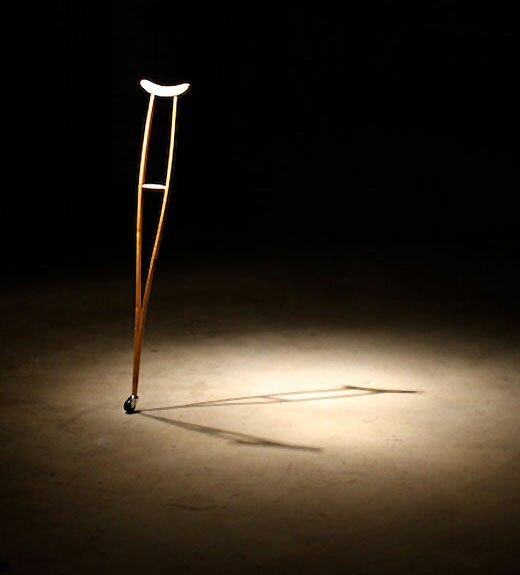 EMV: Kristy, you’ve been an artist primarily working in the sculptural realm. Ever since you won the Artist Foundation Grant [correct me on the title/specifics], seems like you’ve been getting steady shows and making stronger work. Why are so many objects gilded? I know Glasstire posted a nice photograph of the gilded dog bone, but they didn’t let you explain yourself. Want to do that here?
EMV: Kristy, you’ve been an artist primarily working in the sculptural realm. Ever since you won the Artist Foundation Grant [correct me on the title/specifics], seems like you’ve been getting steady shows and making stronger work. Why are so many objects gilded? I know Glasstire posted a nice photograph of the gilded dog bone, but they didn’t let you explain yourself. Want to do that here?
KP: Yes, in 2007 I was the first recipient of the Chez Bernard grant for underrepresented artists. This is a grant made possible by Mr. James Lifshutz on behalf of his father Bernard Lifshutz for the Artist Foundation of San Antonio. The foundation itself is the brainchild of Betty Ward and Patricia Pratchett. You know I have to say here, that the opportunity I was provided by this group of people/artists/patrons really helped a dream come to fruition. I mean I got to have my hand in every part of making that show happen. It was pretty damn close to…here’s some money, find a place, make some work, and let us know what you need, to set it up the way you imagine it. That kind of freedom and support was something I had never experienced befor. It was empowering. I would encourage any artist to check out the A.F. website and learn more.
I’ve worked for the past 4 years as an assistant to art conservator, Anne Zanikos. My duties at work are primarily frame restoration and conservation of polychrome wood objects and so it was here that I was introduced to gilding. Somewhere along the way using gold leaf in my artwork became inevitable. I had seen what it could do for a surface but also, the preparation involved before an object is gilded is quite meticulous and labor intensive. This process forced me to be disciplined, and really learn the craft in order to be rewarded in the end with this beautiful glowing object. The whole tactile experience presented itself as an invitation. In contrast, using the material in my sculpture I bring my understanding of the craft but sometimes allow myself to be more free or loose in the handling…in hope for some poetry along the way. I guess it would be good to note here that gold being “arguably” one of the most precious commodities in the world really serves its purpose when using it in juxtaposition with an everyday, overlooked or forgotten object.
EMV: Being based in San Antonio, do you find it difficult to gain curatorial and critical attention outside of this South Texas sphere?
EMV: Do you consider yourself a feminist artist? What does that mean in 2008 anyway, with the porno Martha Rosler image as the catalog cover for all things documented as feminist art [WACK: Art and the Feminist Revolution]?
KP: I hope that everyone who hears this name goes and looks it up – HARMONY HAMMOND. Now that’s a feminist artist.
Posted by michelle on 25 Aug 2008 | Tagged as: interviews, wordy
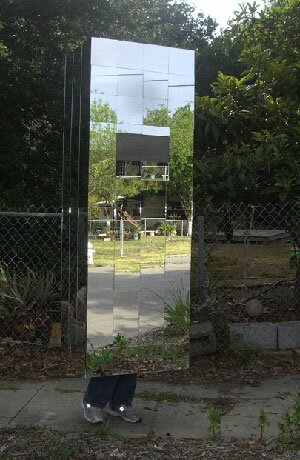 EMV: So, tell me about “Tiny Acts of Immeasurable Benefit” and how you came up with this new body of work.
EMV: So, tell me about “Tiny Acts of Immeasurable Benefit” and how you came up with this new body of work.
KP: I have been thinking about making this body of work for a couple of years. After “Bitchen [Pell's art installation at Artpace in 2007],” I thought I had solved my problem of how to frame my work- kind of to work as a story teller and flesh it out with artifacts and documentation. But sometimes I just get a small idea- kind of a flash image and want to make a piece that breaks my heart- and I am interested in describing a culture of acceptance and cooperation. So, that’s what these pieces are. Sure, there is bitterness, too, but that is because we are looking at the pieces through our own eyes. We project the irony on them. They don’t point out any sort of contradiction within themselves (except for the prints). Sure, maybe I will make sort-of-narrative shows like “Bitchen” in the future…
EMV: I saw you walking around La Tuna inside a mirrored box. it’s a playful and striking piece that seems half architecture and half Dadaist costume. Why did you make this piece and how is it connected to your ongoing work?
KP: I have been interested in the re-emergence of the Islamic headscarf by second generation Americans and Europeans as a way of asserting a religious identity, especially since a lot of their moms don’t wear them. How much of it is simply rebelling against parents, a new identity, or is it the same impetus that makes teens still wear the black trenchcoat after Columbine (oooooh an arab, scary)? I know it is also a profound religious resurgence for many, but I’m sure there is a mixture going on- then I extended it to the burqa. And thought, what if I made a burqa that had the opposite effect from wearing one would in San Antonio today- one that actually made the woman wearing it become a reflection of everything- so that it fits in everywhere and everyone loves the wearer because it reflects the viewer? But i didnt make a flowing burqa because thats diadactic and not funny. So i made a box, then it looked like a disco-ball-duck-blind-confessional, so i called it “Blind for Everything.” Then it had a sort of cool wordplay, you know: blind, camouflage, another piece about how we build ourselves by making choices out of what we see (like Mick , like “Bitchen”).
EMV: How has your vision changed, if at all, since your residency at Artpace?
KP: I have made the same work since I was a kid- about how I see myself and how class and background combine with the sort of dreamy role-modeling we can create from literature, TV, magazines and religion. To me, the most typical thing an American can say is “I’m not your typical american,” to think you are not a type, to think you built yourself out of dust , to see yourself as a Horatio Alger of coolness, artistic integrity, wealth, musical tastes, fashion. I haven’t had the budget I had at Artpace so I have to put some of my more expensive projects on hold till i can save up.
Posted by ben on 24 Jul 2008 | Tagged as: design, interviews, performance art, public art, renegade performances, silliness
Matt Fleeger from KRTU 91.7 (where I am a volunteer DJ) just sent us his interview with Cruz Ortiz about the Contemporary Art Month Pushcart Derby. The interview aired this airs tomorrow morning, and the Derby is this Saturday at Dignowity Park (see our event listing). We’ll be posting photos and video of the derby for those of you out there who crave mediation. Click on the little play button below to listen.
Posted by ben on 31 Jan 2008 | Tagged as: adventure day, art paparazzi, arts organizations, celebrity sightings, interviews, outsider
A little while back we did a series of posts on publicly accessible outsider artwork in San Antonio. One of the artists we covered was the Rev. Seymour Perkins, a controversial figure who lives on the east side of town. While others argue over whether he harbors drugs and prostitutes, and his lawyer battles with the city over the fate of his home, we here at Emvergeoning decided to take another peak at the work that isn’t so publicly accessible — the work inside his home. As Rev. Perkins gave us the tour I tried to absorb all the details, while Justin Parr snapped shot after shot of the inner sanctuary. From what I was able to gather, Seymour Perkins’ daughter, Debbie Jo Christi, was killed in a drug-related conflict on February 22, 1994. Here is a drawing on one of the walls that depicts her murder:
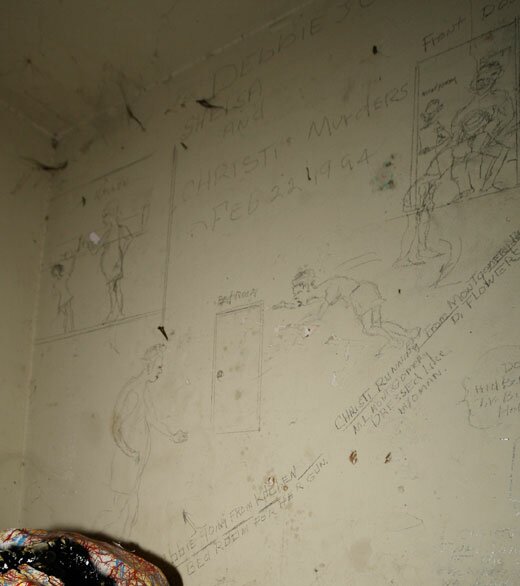
On the same day, the tallest angel in Heaven appeared to Seymour Perkins, revealing to him a tunnel that runs under his home, which is in fact the famous Underground Railroad. This tunnel connects his home to the Alamo and the Menger Hotel, and runs on down into Mexico. After receiving this prophecy (which I am recounting in only a very fragmentary and woefully incomplete way), Perkins founded the Debbie Jo Christi Museum, and Hanging Tough Ministries. Here is a painting of the tunnel running under the Perkins estate:
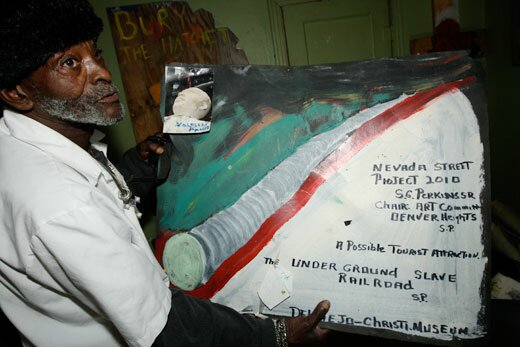
Here are a few shots inside the Debbie Jo Christi Museum:
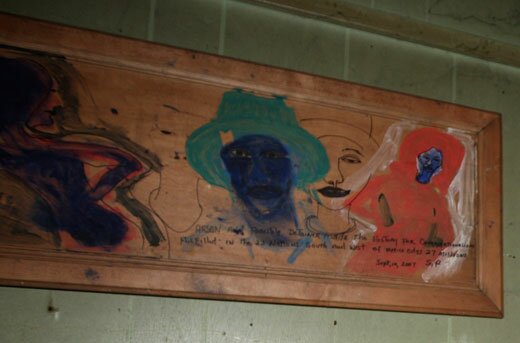
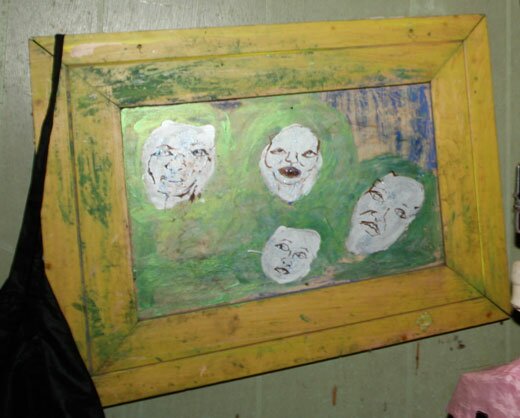
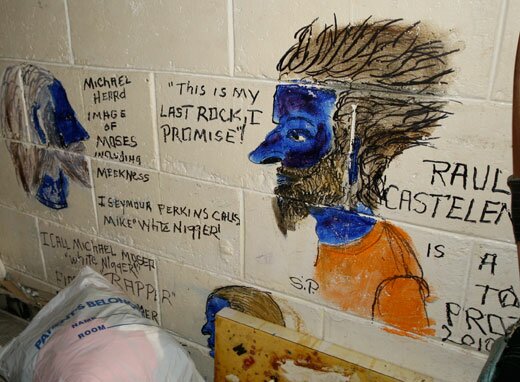
The Museum is located in a small building in the back of the house. But within the actual house, where Rev. Perkins delivers most of his sermons, there are a number of fascinating works. In his bedroom, the pieces below are painted on the wall. The first is a self-portrait of Rev. Perkins with his son:
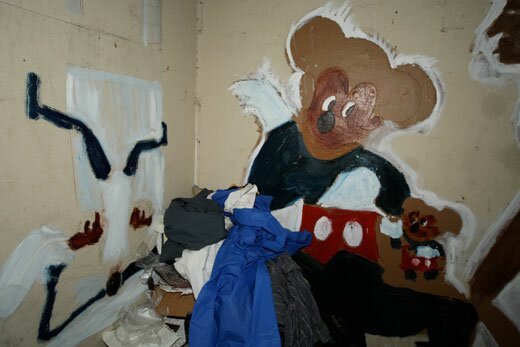
Next to this painting, is a larger work depicting one of his assistants, whose ass is stuck to his ass (i.e. he doesn’t know if he’s coming or going):
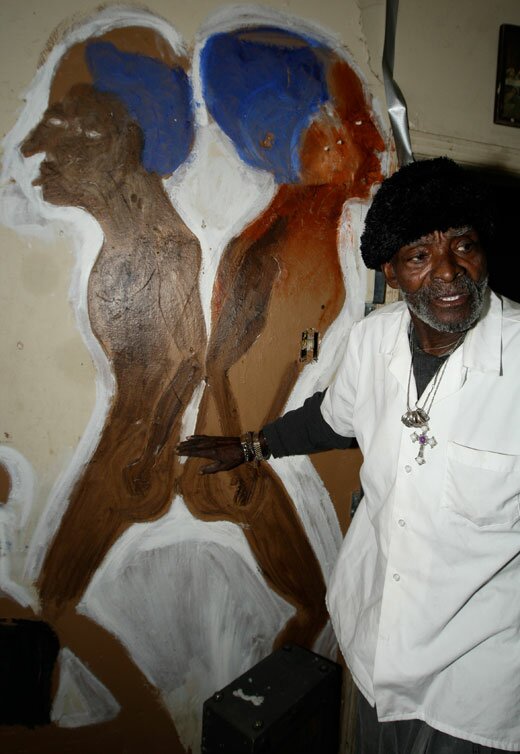
Below are a few details of one work painted on a window shade, depicting a man named Timothy Ringer, “the funkiest man in San Antonio”:
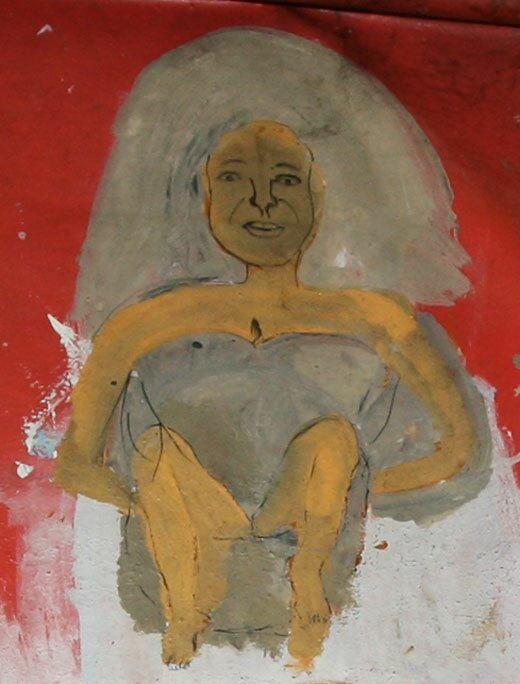

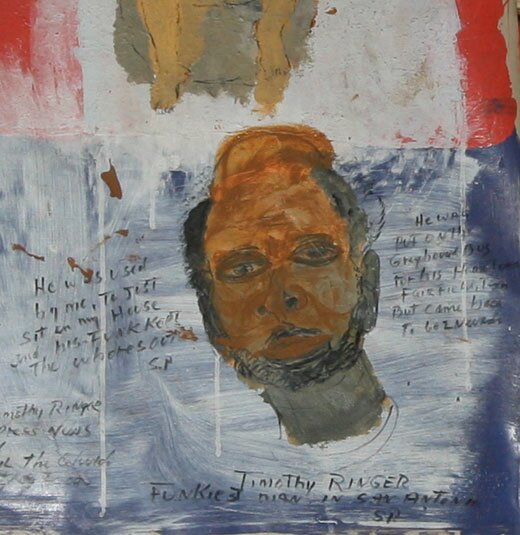
In addition to these works, dealing with himself, his family, and other meaningful people in his life, Perkins showed us a few pieces dealing with his relationship with God and History:
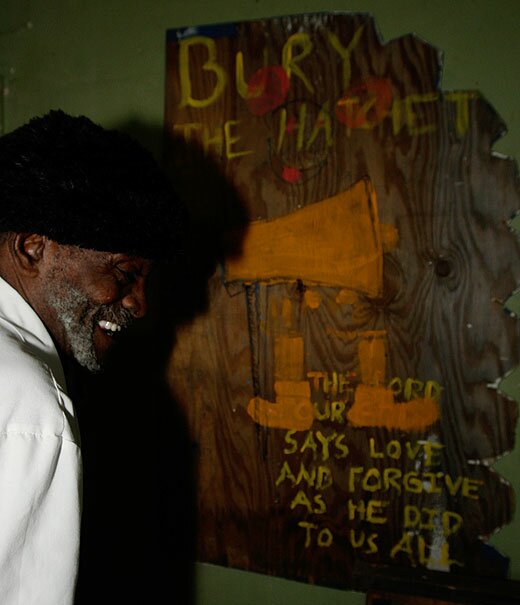
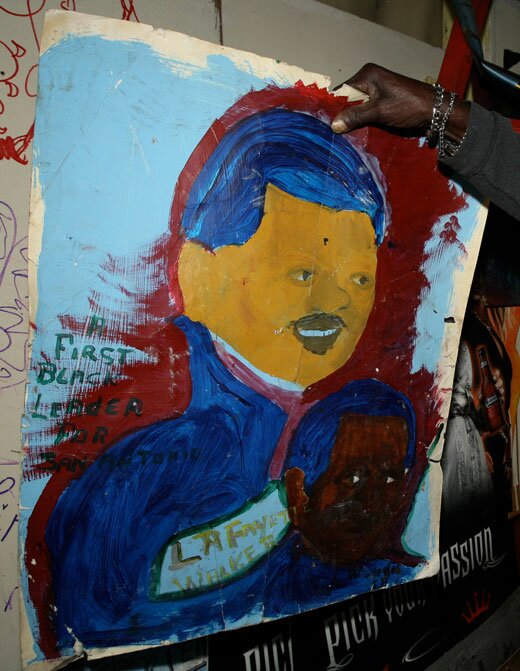
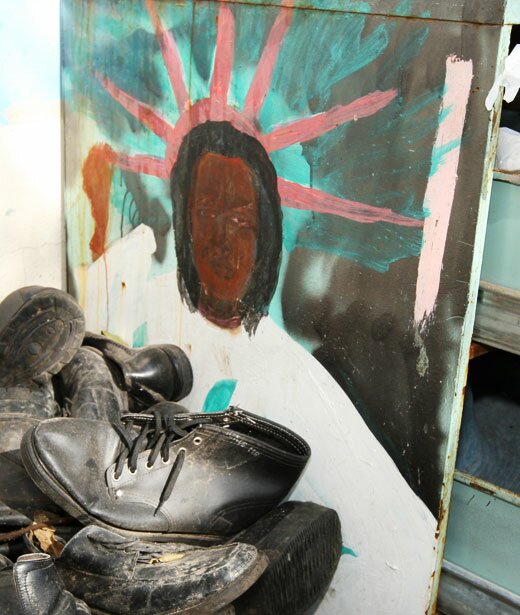
Now, this post isn’t intended to rally support around Rev. Seymour Perkins, or to say anything about his proper place in our community. I’ll leave that to his neighbors, his lawyers, and the city’s elected officials. But I did think it would be good for people to see what is inside his home — if it is destroyed in the coming months, this may sadly be one of the most complete documents of what it contained. To see more of his work, please visit the San Angel Folk Art gallery in the Blue Star arts complex.
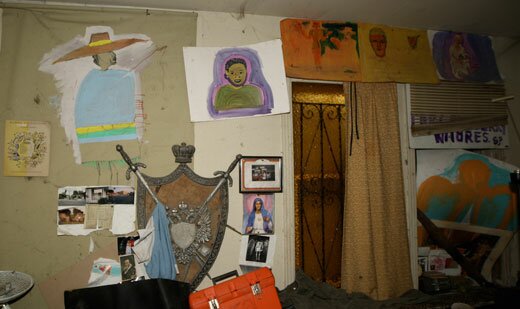
Posted by ben on 06 Dec 2007 | Tagged as: borders, interviews, responses/reviews

This 1993 article / interview from Art in America about Richard Prince’s use of images of women deals with some important issues, including perception, appropriation, and feminism.
BW: You’re talking about the humor of the jokes, but a lot of them are incredibly hostile as well.
RP: Yeah. The comedians that I’ve met are certainly not the happiest people in the world. But that’s not really what I’m about, this kind of hostility or anger or tragedy. l’m mostly thinking in a very boring way. It’s really about going into the studio every day and working, so many of my concerns are really formal, straight-out, boring problem solving.
BW: I guess what I’m leading up to is that a lot of women think that your anger is directed at women.
RP: I like women. I have no problem with women. I’ve heard this and it upsets me to a point, but actually I think it’s a rumor. I know lots of women who like my work and understand it. I think that’s a generalization. There’s nothing directed against women.
BW: Maybe you could talk about another series that enraged a lot of women: the so-called biker chicks.
RP: Well, as far as the biker chicks are concerned, I just wouldn’t mind being one. I’ve never said that before, but I think that’s what I really feel. There’s a certain kind of desire and a certain amount of passion. I like what I think they look like, or perhaps what they are. I think many of these pictures have their own egos and they have an imagination of their own. That’s my own particular reaction. I also think the biker chick is perhaps a more realistic representation than the Grace Kelly girl-next-door. I mean, the biker chicks are the girls next door. The title of the series, “Girlfriends,” is a nonfiction title; those girls are girlfriends. The pictures are taken by their boyfriends and published in a magazine. It’s not like a cult or anything. There are four or five of these large-scale, mass-market publications. Maybe I like women like that.
Posted by ben on 10 Nov 2007 | Tagged as: announcements, books, interviews
My interview with Alan Licht is now available in the newest issue of NeoAztlan. Also in this issue: Kate Green interviews Angela Bulloch and Steve Peralta interviews Ioana Nemes. Licht’s on sound art came out this week as well; look for my review in the upcoming issue of Artlies.
Posted by ben on 27 Apr 2007 | Tagged as: interviews, music
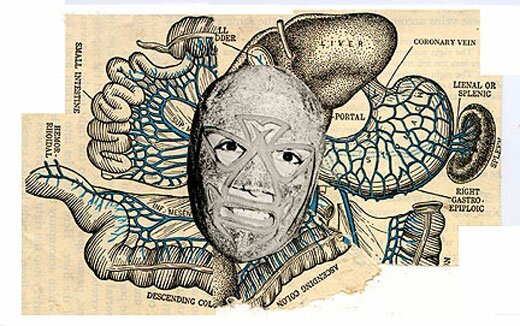
You all know Mark Mothersbaugh for his role in the founding of DEVO, for his work on various soundtracks (including the Pee-wee Herman Show, Rushmore, The Rugrats, and even Revenge of the Nerds II, among others). Although he is less known for his visual art, he has been steadily producing work in this area for decades; in fact, it was while studying art at Kent State that he formed DEVO, partly in response to the Kent State shootings. His work draws on ideas pioneered by the Fluxus movement, with its mixture of whimsy and starkness. Mothersbaugh’s “Postcard Diaries” will be opening at FL!GHT Gallery on May 12, alongside an installation by Sarah Higgins at Salon Mijangos, new work by Kelly Pierce at One9Zero6 Gallery, and music by Hyperbubble and others. He recently agreed to do an email interview with me: Continue Reading »